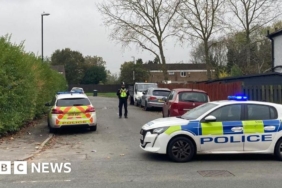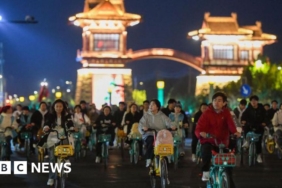Kaynak: www.npr.org

Minnesota Gov. Tim Walz signs the budget bill on May 24, 2023, on the steps of the State Capitol in St. Paul, Minn., in front of hundreds of supporters.
Glen Stubbe/Star Tribune via Getty Images
hide caption
toggle caption
Glen Stubbe/Star Tribune via Getty Images
Tucked at the bottom of the ballot, races for the state legislature can have an enormous effect on issues from abortion to guns to voting access.
Control of legislatures is up for grabs in several states this year. Republicans are defending vulnerable majorities in Arizona, New Hampshire and Wisconsin, and Democrats are trying to stay on top in Michigan, Minnesota and Pennsylvania.
And as Congress remains largely gridlocked, state legislatures are productive, introducing more bills, and passing more laws.
That’s partly because nearly every legislature is controlled by one party or the other, making it easier to pass laws over the objections of political opponents. Republicans control 28 legislatures. Democrats have 20.
It’s also due to a series of conservative U.S. Supreme Court rulings that handed states the power to regulate issues from abortion to environmental policy.
The Supreme Court has rolled back national standards and put state governments in the spotlight, says Jake Grumbach, an associate professor at the Goldman School of Public Policy at the University of California, Berkeley.
“So that increases the difference between red and blue states and makes the state level more important,” Grumbach says. “Your state of residence now is more important for your life and your relationship to government than it has been since probably soon after the Civil Rights era.”
In response, political parties and other groups are spending big money to try and influence who gets elected to serve under capitol domes around the country.
The Democratic Legislative Campaign Committee, the main fundraising arm for statehouse Democrats, set a $60 million budget to support legislative races this year. Forward Majority, a group aligned with Democrats, is planning to spend $45 million this cycle. And The States Project, another progressive group, announced a $70 million goal earlier this year.
The Republican State Leadership Committee, the DLCC’s GOP counterpart, recently announced an increase of their initial $38 million commitment to $44 million, sounding the alarm on the fundraising gap with Democrats in a memo to donors late last month.
“As Democrats pump money into late television, digital, and canvassing efforts to overwhelm our candidates with false attacks, we must double down on our targeted investments to keep our campaigns competitive through Election Day,” the memo states.
Republicans have controlled more legislative chambers since an organized blitz ahead of the 2010 elections, allowing the party to cement control of both statehouse and congressional districts through redistricting in ensuing years.
DLCC President Heather Williams says Democrats have been building back in order to be strongly positioned in the 2030 redistricting cycle when they could be in position to draw voting maps.
“We certainly look at the election in front of us and are identifying where the opportunities are. But we are also responsible for crafting this long-term strategy to win power in the states over the decade,” Williams says.
As for which policies are front of mind for voters, Williams says abortion, protecting access to the ballot and education are top of mind in a year when the presidential election is taking up most of the oxygen in the room.
“We know that federal solutions to these big issues that we care deeply about are so important in this country. And while we wait to build that power, those decisions are being made in our statehouses every single day,” she says.
States where legislative control hangs in the balance this year
The political battlegrounds for state legislatures largely mirror the map of swing states in this year’s presidential election — Arizona, Michigan, Pennsylvania, Wisconsin — and two states where parties have narrow control of both legislative chambers and governor’s office — Democratic-led Minnesota and Republican-led New Hampshire.
Democrats are hoping backlash to the 2022 U.S. Supreme Court ruling that overturned Roe v. Wade will lead to a surge of voters in tightly controlled legislatures. In Arizona, Democrats say they believe they have a chance to win total control of the Legislature and governor’s office by unseating GOP lawmakers who voted against repealing a Civil War-era abortion ban earlier this year. Republicans are defending narrow two-seat majorities in both the state House and Senate.
In Michigan and Minnesota, Republicans argue that progressive policies enacted by the recently minted Democratic trifectas have pushed the states too far to the left. Since winning reelection in 2022, Michigan Gov. Gretchen Whitmer signed a package of progressive policies including abortion protections, gun safety and repealing so-called “right-to-work” legislation. Since Democrats won the governor’s office and both legislative chambers in Minnesota, Gov. Tim Walz has signed bills that provide free meals for kids at school, restore voting rights to some people with felony convictions and reinforce abortion access and transgender rights.
And Democrats are trying to break apart a Republican trifecta in New Hampshire, where control of the largest-in-the-nation Legislature has bounced back and forth over the years. New Hampshire is one of the few states in New England without abortion protections enshrined in its state constitution and Democrats hope the issue, along with an open election for governor, will boost turnout.
In Pennsylvania, one of two legislatures with split control, Democrats are trying to continue momentum from the statewide victories of Gov. Josh Shapiro and U.S. Sen. John Fetterman. But Republicans hope the flood of national attention during the presidential election, including the attempted assassination of former President Donald Trump in western Pennsylvania, will spur voters to put a check on Democrats in the state.
Republicans have controlled the Wisconsin Legislature for more than a decade under political maps that favored the GOP. But Democrats hope new maps — redrawn by Democratic Gov. Tony Evers after the state Supreme Court struck down Republican-drawn maps in 2023 — will lead to a shakeup of the GOP-led Legislature. According to Wisconsin Public Radio, at least 61 members of the state Assembly and Senate won’t run in their old districts — nearly half of the Legislature. Democrats are running candidates in 97 of the Assembly’s 99 races and in each of the 16 open Senate races.






Yorumlar kapalı.